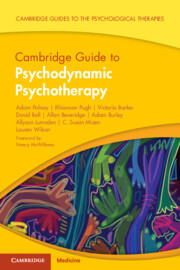Book contents
- Cambridge Guide to Psychodynamic Psychotherapy
- Cambridge Guides to the Psychological Therapies
- Reviews
- Cambridge Guide to Psychodynamic Psychotherapy
- Copyright page
- Dedication
- Contents
- Foreword
- Preface
- A Note from the Series Editor
- Acknowledgements
- Part 1: An Overview of the Model
- Chapter 1 An Historical Overview of Psychodynamic Psychotherapy
- Chapter 2 The Supporting Theory of Psychodynamic Psychotherapy
- Chapter 3 A Brief Description of the Empirical Basis of Psychodynamic Psychotherapy
- Chapter 4 An Outline of Psychodynamic Psychotherapy
- Part 2: The Model of Psychodynamic Psychotherapy into Practice
- Part 3: Application for Mental Health Presentations
- Part 4: Application of Psychodynamic Psychotherapy in Different Populations and in Different Settings
- Glossary of Terms
- Index
- References
Chapter 3 - A Brief Description of the Empirical Basis of Psychodynamic Psychotherapy
from Part 1: - An Overview of the Model
Published online by Cambridge University Press: 25 August 2023
- Cambridge Guide to Psychodynamic Psychotherapy
- Cambridge Guides to the Psychological Therapies
- Reviews
- Cambridge Guide to Psychodynamic Psychotherapy
- Copyright page
- Dedication
- Contents
- Foreword
- Preface
- A Note from the Series Editor
- Acknowledgements
- Part 1: An Overview of the Model
- Chapter 1 An Historical Overview of Psychodynamic Psychotherapy
- Chapter 2 The Supporting Theory of Psychodynamic Psychotherapy
- Chapter 3 A Brief Description of the Empirical Basis of Psychodynamic Psychotherapy
- Chapter 4 An Outline of Psychodynamic Psychotherapy
- Part 2: The Model of Psychodynamic Psychotherapy into Practice
- Part 3: Application for Mental Health Presentations
- Part 4: Application of Psychodynamic Psychotherapy in Different Populations and in Different Settings
- Glossary of Terms
- Index
- References
Summary
There is a growing body of research pertaining to the empirical basis of psychodynamic psychotherapy, with contributions from various angles. These include clinical trials, studies of live therapy sessions (process research), transference and countertransference research. Our aim here is to give a readable and clinically relevant brief description of the empirical basis of psychodynamic psychotherapy, making links to other parts of this book where topics are described clinically.
Keywords
- Type
- Chapter
- Information
- Cambridge Guide to Psychodynamic Psychotherapy , pp. 51 - 64Publisher: Cambridge University PressPrint publication year: 2023



